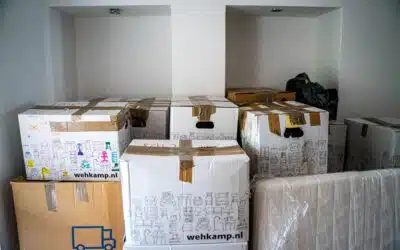The Average Cost of Removals in the UK Moving can be a stressful and expensive process, especially when it comes to hiring a removals company. The cost of removals in the UK can vary depending on several factors, including the...
How to label boxes for moving?
Moving to a new house can be stressful, especially if it’s your first time. The process involves a lot of organisation, and feeling a bit overwhelmed is normal. The pressure mainly comes from getting everything ready for the move and dealing with the emotions of such a significant change in our lives.
For those moving for the first time, planning ahead is important, like looking for a moving service in advance and packing belongings properly. To avoid last-minute panic, it’s a good idea to research and get quotes from a few removal companies. Start packing early and make sure to label the boxes correctly. It will help you easily find your things when unpacking in your new home. Taking these steps can make the moving process smoother and less stressful.

Labelling is crucial during a move
Picture this: your new home is in chaos, and you’re on the verge of tears, searching for your stuff in a sea of unmarked boxes. Can you handle that? Probably not. That’s why labelling your boxes while packing is a must.
Choose an easy-to-understand code system to describe the box’s contents and destination. This simple step will save you from a lot of trouble when you need to find something later. It also helps the movers know the order for loading boxes onto the truck.
Clearly labelled boxes make unloading and arranging items in your new home much smoother. Plus, marking fragile items ensures they’re handled with care. Numbering each box helps you quickly spot if one goes missing.
Now, what’s the best way to label your moving boxes? Is there a universal system that works for all situations?
Get ready for packing and labelling with these essentials
- Cardboard Boxes or any storage containers
- Coloured paper
- Paper Tape
- Pens and a few sheets of paper
- Clear Packing Tape and Coloured Tape
- Quality permanent markers in various colours
You can either download printable moving box labels or create your own. These materials will make your packing and labelling process a breeze.
Check also:
How to Lift Heavy Objects Without Harming Yourself?
Moving House Checklist: A Comprehensive Guide
Before you begin packing, create a master inventory list
How to label moving boxes properly
Labelling moving boxes doesn’t have a one-size-fits-all approach. You can use various effective labelling methods without causing confusion. Proper labelling aids professional movers on the moving day and simplifies the unpacking process for you. Prepare your packing and labelling supplies, and let’s get started!
Simplify your unpacking by using different colours to label your moving boxes. This method works well with room-by-room labelling, assigning a unique colour to each room. For example, mark “Kitchen” with a yellow permanent marker and “Living room” in blue, ensuring removalists place each box in its designated area. Use quality waterproof markers to prevent smudging on moving days in case of rain or snow.
Seal boxes with matching or clear tape over the corresponding colour paper to reinforce your colour-coded system. Carry the colour code into your new home by attaching the same colour tape or paper to the doors of each room. It ensures clear communication with movers, saving you time rearranging boxes later.
Check also:
How to simplify my home move?
What are the standard house removal mistakes, and how to avoid them?
Room Labels
Let’s talk about the room-by-room packing system. It’s a proven method that makes unloading and unpacking a breeze, even with just one label colour. Tape the same label on each side and place one on the box for easy identification.
This approach dramatically helps movers find the right room promptly. It avoids the inconvenience of searching for a label or moving a box because the label is on the other side.
Priority Code Labels
This labelling system combines a couple of house removal concepts. It helps determine the order of loading boxes onto the moving truck. Removalists can prioritise unloading items, ensuring they go to their designated rooms.
The idea is also to remind yourself which box is a priority before unpacking, making the process more organised and efficient.
Number Code Labels
Remember our advice about creating an inventory list? Well, the number code labelling system builds on that. Assign a number to each box in your inventory list and note which numbers belong to each room. For instance, when unpacking boxes 1 to 5, you can quickly reference your list to identify items destined for the kitchen.
If your priority is making tea, you can swiftly grab box number 3 for the kettle. It’s helpful to label box 3 with a clear “Kitchen” in red for the removalists to direct it easily.
Labels by Items
Packing items by category is a partial method and can’t replace other labelling systems. For example, group soft items like bedding, throws, rugs, and cushions together, or pack your kids’ winter clothes in a large bin bag. Use paper tape to label bin bags and plastic containers.
Another example is packing and labelling camping equipment with an added “L” for low priority. Small electrical appliances that require careful handling can also go in a designated box.
Decide how to group items, like packing the hairdryer and table fan with the coffee maker and juicer. Find what works for you by considering the pros and cons of this labelling system, with clarity in itemising the contents of each box being the key.





